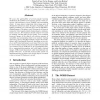Free Online Productivity Tools
i2Speak
i2Symbol
i2OCR
iTex2Img
iWeb2Print
iWeb2Shot
i2Type
iPdf2Split
iPdf2Merge
i2Bopomofo
i2Arabic
i2Style
i2Image
i2PDF
iLatex2Rtf
Sci2ools
CVPR
2004
IEEE
2004
IEEE
Learning Methods for Generic Object Recognition with Invariance to Pose and Lighting
We assess the applicability of several popular learning methods for the problem of recognizing generic visual categories with invariance to pose, lighting, and surrounding clutter. A large dataset comprising stereo image pairs of 50 uniform-colored toys under 36 angles, 9 azimuths, and 6 lighting conditions was collected (for a total of 194,400 individual images). The objects were 10 instances of 5 generic categories: four-legged animals, human figures, airplanes, trucks, and cars. Five instances of each category were used for training, and the other five for testing. Low-resolution grayscale images of the objects with various amounts of variability and surrounding clutter were used for training and testing. Nearest Neighbor methods, Support Vector Machines, and Convolutional Networks, operating on raw pixels or on PCA-derived features were tested. Test error rates for unseen object instances placed on uniform backgrounds were around 13% for SVM and 7% for Convolutional Nets. On a seg...
Computer Vision | Convolutional Nets | Convolutional Networks | CVPR 2004 | Generic Visual Categories | Low-resolution Grayscale Images | Unseen Object Instances |
| Added | 12 Oct 2009 |
| Updated | 12 Oct 2009 |
| Type | Conference |
| Year | 2004 |
| Where | CVPR |
| Authors | Fu Jie Huang, Léon Bottou, Yann LeCun |
Comments (0)

